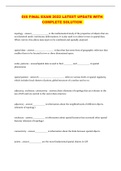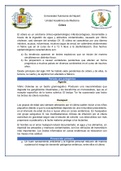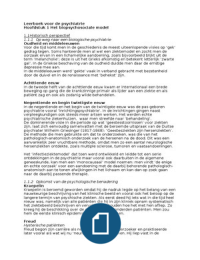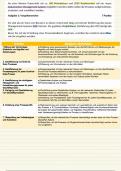repair deficiencies >> exception: Maslow hierarchy of needs, and how to achieve full potential. Positive
psychology: (around 2000) “to find and nature genius and talent and make normal life more fulfilling” >
includes well-being, happiness, character building (Csikszentraihalyi: flow; Seligman) >> current focus is on
cognitive achievements: what can we do to improve performance? Focus of the course Cognitive
enhancement assumes a role of nurture, despite nature! Golden standard of scientific research Ideal:
random control trial (Pretest/posttest x intervention condition; Still scarce; Beware of researchers with
hidden agendas, even among the authors of the current papers) >> by analogy to homeopathy vs
medicine: Useless popular techniques replace better techniques. Common mistakes in intervention
research: Poor design (No control group; Sampling error (including cross-sectional comparison); Groups not
matched; Raising expectations; No baseline measurement (pretest)). Bad habits (Lack of statistical power;
Publication bias; Selective reporting from multiple dependent variables; Over-reliance on alpha = 0.05).
Understanding the mechanisms (why an intervention is effective or not) Some main ingredients: 1.
Limiting factors (Concept derived from biology: cognitive performance can only improve if the limiting
factor is optimized). 2. Dependence between processes (Sequential dependence: temporal output-input
relationship > Performance on process N+1 depends on process N; Thus, working memory performance
may be improved by facilitating perception and attention); Competitive dependence (capacity limitations):
sum of processing requirements exceeds the capacity or resources > Enhancement by: reducing load
(intervene with task demands, executive control) and/or increasing capacity (intervene with motivation,
attention, energy levels)). 3. Optimal states Non-linear relation: optimum + inverted U (Example: amount of
arousal). 4. Neural mechanisms For example: Myelin, connectivity, plasticity; Neuromodulators such as
dopamine and norepinephrine; Long term potentiation; Firing rate; Oxygen, glucose. 5. Individual
differences What works best for person X? personalize treatment!; Limiting factors + optimal levels; For
example (older man with diabetes): where is performance gain possible? Limitations: glucose (too high),
attentional focus, dopamine (too low), processing speed (too low). Contextual influences 1. Circadian
rhythms. 2. Effects of light. 3. Effect of sound. 1. Circadian rhythm = Rhythms of approximately 1 day.
Types of sleep: Sleep urge = biological clock (How strongly you currently feel that you want to sleep; Two
peaks: after noon (post-lunch dip)). Sleep need/debt = time since sleeping (Increases during the day). Type
effects: Morning type; Evening type. Age effects: Adolescents are slow starters; Older adults are early
starters. Sleep/wake cycle is driven by: 1. Internal clock = pacemaker (Body temperature; Cortisol (promote
wakefulness); Melatonin (promote sleep); Chronotype (morning or evening type)). 2. Sleep dept (Shortage
vs anticipated sleep); 3. Zeitgebers =time indicators (Light (registered in supra-chiamastic nucleus);
Habits/demands); 4. Unusual (but normal) demands (Jet lag; Night shift). Phase shifting interventions:
Adjusting internal clock: Best at start of intended sleep = Melatonin; Hypnotic drugs. Best at start of
intended waking = Caffeine; Amphetamine; Modafinil. Sleep dept: Best prior to intended waking = Naps.
Zeitgebers: Best at start of intended waking = Bright light. Best at start of intended sleep = Dimming
goggles. Shifts: Sustain shift, avoid interruption; Optimal intervention depends on advancing vs delaying
shift and on individual differences and age. Napping Positive: To fight the post lunch dip: valuable in risky
working conditions; Short naps (10-20min) improve alertness for > = 3 hours; Longer naps (60-90 min)
improve procedural and declarative memory for prior experiences. Negative: Sleep inertia after the nap >
especially after longer naps; Too frequent napping disrupts nighttime sleep. Night cycle Deviant sleep cycle
> errors + societal risk, growth- and metabolic problems, immune deficiency, fatigue, attention problems,
bad mood, poor learning. Threats to sufficient sleep: Old age; Shift work/night work; Irregular sleeping
habits; Stress – elevated cortisol; Jet lag. Effects of sleep deprivation Reduced activity fronto-parietal
network and less dopamine signaling > less goal-directed on-task activity; Increased activity in the default
mode network > more automatic mode and off-task activity >> negative effect on learning, attention, risk
taking. Sleep’s role in the consolidation of memory Slow Wave Sleep (first half of the night): system
consolidation, global effects (Neocortex – hippocampus; Reorganization and reactivation of relevant
,daytime memories; Downscaling of memories > higher signal noise ration; Particularly good for declarative
memory). During the day you have stored memories in temporary store (=hippocampus) and it is then not
yet sufficiently linked to neocortex. During night: all memories in temporary store remain active and can
enter the longterm store. Rapid Eye Movement Sleep (second half of the night): synaptic consolidation,
local effects (Effect of hippocampus is largely gone; Long term potentiation is strengthened; Hippocampus
independent; Particularly good for procedural memory). Improvement of existing connections in longterm
store > so what just has been updated during first half of sleep > will now be even more strongly reinforced
by consolidation. 2. Effects of light Blue light Basic explanation: Light effects on cognition traditionally only
attributed to rods and cones > peak sensitivity = to green light. New explanation: Retinal ganglion cells
(non-image forming) seem to play a stronger role for translating light to alertness > these cells are sensitive
to a specific part of the spectrum of light >> peak sensitivity = to blue light >> alertness > cortical activity
level > attention, memory, executive control, etc. Blue light reaches SCN (suprachiasmatic nucleus = part of
hypothalamus) + LC (locacuruleus = supports release norepinephrine to cortex) >> Blue light therefore
causes arousal >> blue light is also in sunlight > so during the day it is a useful effect > helps you to stay
awake >> but also in LCD and LED > causes you to be aroused long after the exposure of blue light. Color
affects cognitive performance, mood etc. (many (isolated) findings about effects of color on cognition): Red
> detailed processing and memory retrieval, avoidance; Blue > creative thinking. Mechanism largely
unknown – possibly learned association. Study: Philips + university twente: possible to enhance class
performance by the right choice of lighting? >> dynamic lighting adjust to the time of day >> conclusions
are premature: these direct relations have not been clearly demonstrated. 3. Effects of sound Mozart
effect: Claim: following Mozart exposure or piano training > children and students perform better at spatial
and math tasks (Priming of spatial areas by musical perception?? No convincing link; Alternative: effects on
mood and arousal) >> meta-analysis: no spatial enhancement >> not specific to Mozart: also Schubert,
Blur, child play song, Stephen King story etc >> exposure is not experience: active musical experience is
correlated with control, mathematical, spatial, linguistic ability and g. But does not deserve the name
Morzart effect. >> acute after effects should not be confused with lasting effects, or effects of background
music. Does music make you smarter? Causality has not been demonstrated, but correlations are clear:
(mozart’s) music > executive functions > IQ; IQ > executive functions + music activity. Music at work Self-
chosen music modulates mood; Mood modulates performance; Mood = valence (positive/negative) x
arousal (low/high). Beneficial effects of music if: Work does not require sequencing (including reading,
write, calculate); Valence is moved in the right direction (Positive valence ~ creative, divergent thinking;
Negative valence ~ analytic, convergent thinking); Arousal is moved in the right direction (Lower arousal (=
relaxing) ~ reducing; Higher arousal ~ increasing alertness (e.g. in the morning)) >> music van be useful as
self-regulator > but arousal should be close to optimal for focused learning. Whether music at work is a
good idea depends on the limiting factor: Working memory (and other) capacity limitations: Efficient
learning requires maximum attention, routine jobs (no risk) do not; Costs of concurrency; Costs of
monitoring; Costs of storage; Costs of switching; Interference (e.g. textbook x lyrics). Distraction and
interruption Interruption: restart again. Dual-tasking almost always influences work performance if both
tasks require attention (Irrelevant speech effect: if speech can be understood > text work and other serial
tasks are impaired; After interruption by a colleague or phone call: task switch costs).
College 2 – Training cognition Trainability and the role of cognitive control Cognitive control Thorndike:
transfer is only possible from the trained activity to identical elements > task overlap is crucial >> so
training of actual cognitive action (e.g. language, math, 7x8=56). Transfer: what you have learned can be
applied in a new setting with new material (and possibly with new cognitive processes) vs Formal discipline
theory: education supports the growth of generic disciplines (widely applicable) like intelligence or working
memory >> Is there transfer to untrained domains and contexts? >> What would be the generic factors
here? Training generic skills (in prefrontal cortex) Cognitive control + working memory capacity +
metacognition: Function prefrontal cortex can change according to situation (Miyake, 2000), main
, functions of cognitive control (=executive function): 1. Inhibiting irrelevant information/habits. 2. Updating
working memory. 3. Switching between task sets/strategies. 4. (+attention, monitoring, planning) >>
multimodal functions with wide applicability > if these can be trained, transfer will be great. Diamond,
2013: >> prefrontal cortex or cognitive control is often the limiting factor in our performance! > that is why
training these is better than other training. Sensitive to: Sleep loss, fatigue; Distraction; Under/overarousal;
Malnutrition; Substance abuse; stress. >> consequences for the extent to which the prefrontal cortex is
activated during the execution of a task >> therefore more easily fall back to habitual behavior >>
therefore: prefrontal cortex/cognitive control/executive function = the canary in the coal mine. Because
deficits in prefrontal cortex/cognitive control/executive functions > sign that something is going wrong >
and will probably affect a wide range of performances. The weakest link 1. Prefrontal cortex is the slowest
to mature and fastest to decline with age >> cognitive control limitations in kids and older adults (due to
myelisation in prefrontal cortex). 2. Brain uses 20% of glucose and 22% of oxygen in the body >> cognitive
control depends on the whole brain and is one of the most sensitive functions to resource depletion.
Helping cognitive control Higher cognitive control is related to (from epidemiology research = comparison
between existing groups > evidence is therefore insufficient. Because all these onderstaande can be
reversed): #years in education; Challenging career; Bilingualism (Improvement switching > improvement
cognitive control); Socio-economic status; Remaining active at high age >> so cognitive control seems
trainable! >> keep in mind: epidemiology research vs experimental research. Experimental support for
trainability of: 1. Working memory: week of N-back task (requires people to update working memory again
and again) > effect; 2. Task switching: days of task switching training > transfer to new tasks that made use
of different task instructions > cognitive control abilities are indeed trainable and there is transfer >> but
many critical notes: expectancy effects, publication bias. How good is the transfer? Tools of the mind
program 3-5 year old children: immature prefrontal cortex; Help come through the demanding phase: use
scaffolds (=support that makes it easier to engage in certain learning activities > allow participant on the
real learning), later on remove them >> to provide structure; Teachers and parents provide structure,
planning and goal maintenance; Playful practice and external control are internalized as discipline > helps
children to stick to rules > it becomes more a automatism; Repetitive control (attentive processing) >
automatic processing > capacity left for new challenges. Comparable approach to training control in
adults Changing behavior requires: Healthy mind; Motivation to learn and change; Support/curriculum (like
scaffolding > make it easier for participants to train their control); Prevention of fall back (absence of
triggers). What is the limiting factor? (e.g. not motivated to quit smoking). Training control in adults 1.
Coach the employee to define and select cognitive control goals that match his/her dissatisfaction =
intrinsic motivation (E.g. I should not lose my temper in front of a client); 2. Coach the choice of an
approach, define the requirements: Colleagues, time, rules etc; 3. Scaffold the fulfilment of these goals:
Write down the goals, use reminders, evaluate progress, evaluate focus, evaluate obstacles; 4. Prevent
falling back: Change the context that supported undesired habits (get colleagues involved); After the goal is
reached, build in repetition. >> (1 = intrinsic motivation; 2 en 3 = reduce cognitive load (= takes heavy
burden from working memory and allows to focus more on what you’re currently trying to improve on.; 4 =
automatic vs controlled). Workplace and control Fail to use cognitive control > cognitive control requires
maintenance > dangerous tendency when you stop thinking. The basics of learning Specific learning
(perception) = identical elements (no transfer to elements that have not been practiced) Training can
improve insight, distinction and pattern recognition >> but it does not transfer to memory for random
chess positions, or detection of new features in X-rays. Specific learning (procedural) Engström (2017)
Automatic vs controlled actions: Repeated tasks with a consistent rule become automatized (= becomes
default behaviour); New and variable tasks have to be performed with cognitive control (= goal-directed
behaviour) >> there is always the risk you fall back to default behaviour; Performing goal-directed actions =
capacity limited >> Performance returns to automatized mode in case of capacity limitations (e.g. cognitive
load, distraction): Cognitive load and distraction are selectively detrimental for tasks that require cognitive











